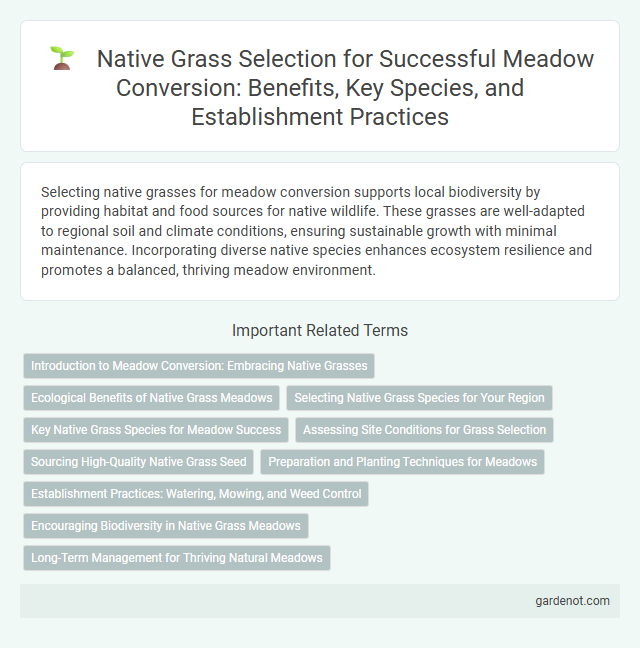Selecting native grasses for meadow conversion supports local biodiversity by providing habitat and food sources for native wildlife. These grasses are well-adapted to regional soil and climate conditions, ensuring sustainable growth with minimal maintenance. Incorporating diverse native species enhances ecosystem resilience and promotes a balanced, thriving meadow environment.
Introduction to Meadow Conversion: Embracing Native Grasses
Native grass selection is crucial in meadow conversion, promoting biodiversity and ecosystem stability by using species adapted to local climate and soil conditions. Indigenous grasses like big bluestem, switchgrass, and little bluestem enhance soil health, support pollinators, and reduce maintenance compared to non-native species. Embracing native grasses ensures a resilient, sustainable meadow that thrives naturally and supports native wildlife habitats.
Ecological Benefits of Native Grass Meadows
Native grass selection for meadow conversion promotes biodiversity by providing habitat and food sources for pollinators, birds, and small mammals. Deep root systems of native grasses improve soil stability, enhance water infiltration, and sequester carbon, mitigating climate change effects. These grasses require less irrigation and chemical inputs, supporting sustainable land management and ecosystem resilience.
Selecting Native Grass Species for Your Region
Selecting native grass species tailored to your region ensures optimal growth, promotes local biodiversity, and supports native wildlife habitats. Consider factors such as soil type, climate, and precipitation patterns to choose grasses well-adapted to local conditions, like Little Bluestem in the Midwest or Big Bluestem in prairie regions. Consulting regional native plant databases or extension services can provide species lists and guidelines to enhance meadow conversion success.
Key Native Grass Species for Meadow Success
Selecting key native grass species such as Big Bluestem (Andropogon gerardii), Switchgrass (Panicum virgatum), and Little Bluestem (Schizachyrium scoparium) is essential for successful meadow conversion. These species offer deep root systems that enhance soil stability, improve water infiltration, and provide critical habitat for local wildlife. Incorporating a diverse mix of native grasses ensures resilience against pests, diseases, and varying climate conditions, promoting a sustainable and thriving meadow ecosystem.
Assessing Site Conditions for Grass Selection
Assessing site conditions such as soil type, moisture levels, sunlight exposure, and existing vegetation is essential for selecting native grasses that will thrive in meadow conversion projects. Native grasses like Big Bluestem, Switchgrass, and Little Bluestem are well-suited for varied conditions but require careful matching to the specific environment to ensure successful establishment. Understanding these factors optimizes plant health, biodiversity, and long-term sustainability of the meadow ecosystem.
Sourcing High-Quality Native Grass Seed
Sourcing high-quality native grass seed is essential for successful meadow conversion, ensuring ecological compatibility and long-term resilience. Selecting certified seed suppliers that specialize in native species adapted to local soil and climate conditions enhances germination rates and biodiversity. Prioritizing provenance-tracked seeds supports native pollinators and maintains genetic diversity within restored meadows.
Preparation and Planting Techniques for Meadows
Selecting native grasses for meadow conversion requires assessing soil conditions and climate to match species like big bluestem, switchgrass, or little bluestem that thrive locally. Proper site preparation involves removing existing vegetation, tilling soil lightly to enhance seed-to-soil contact, and ensuring adequate moisture levels before planting. Planting techniques emphasize broadcast seeding or drilling native grass seeds during the optimal dormant season to maximize germination and root establishment.
Establishment Practices: Watering, Mowing, and Weed Control
Native grass selection for meadow conversion requires careful establishment practices to ensure successful growth and sustainability. Regular watering during the initial weeks promotes deep root development, while mowing at a height of 6-8 inches helps control unwanted weed species without damaging native grasses. Consistent weed control through manual removal or targeted herbicides supports native grass dominance and encourages a resilient, biodiverse meadow ecosystem.
Encouraging Biodiversity in Native Grass Meadows
Selecting native grasses for meadow conversion enhances biodiversity by providing habitat and food sources tailored to local wildlife. Species such as big bluestem (Andropogon gerardii), switchgrass (Panicum virgatum), and little bluestem (Schizachyrium scoparium) support pollinators, birds, and beneficial insects. Diverse native grass meadows improve soil health and ecosystem resilience through deep root systems and seasonal growth patterns.
Long-Term Management for Thriving Natural Meadows
Selecting native grasses such as big bluestem (Andropogon gerardii), switchgrass (Panicum virgatum), and little bluestem (Schizachyrium scoparium) ensures ecological compatibility and resilience. Long-term management involves periodic prescribed burns, selective mowing, and controlled grazing to maintain biodiversity and prevent invasive species encroachment. Monitoring soil health and adapting management strategies over time promote sustainable growth and vitality in natural meadow ecosystems.
Native grass selection Infographic

 gardenot.com
gardenot.com